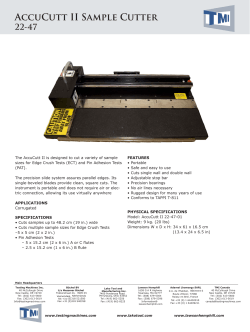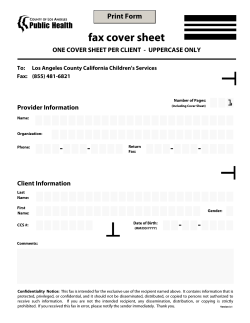
SAFETY MANUAL Surge Protection Devices SIL
Instrument Signal Connections SIL SIL SIL IEC 61508:2010 IEC 61508:2010 IEC 61508:2010 2 1 Protection Devices SAFETY MANUAL Surge SD Series, SD07/16/32/55 all versions and SDRTD, SD150X, SD275X. 3 SLP07D, SLP16D, SLP32D. IOP Series, all versions. TP Series, TP24/7, TP-32, TP-48. FUNCTIONAL SAFETY MANAGEMENT These products are able to be used within a Safety System conforming to the requirements of IEC 61508:2010 or IEC 61511. The products are not Safety Elements but may be used to protect instrument loops designed to achieve Safety Integrity Level of up to SIL3. MTL is a certified Functional Safety Management company meeting the requirements of IEC61508 Part1:2010 clause 6. SIL SIL SIL IEC 61508:2010 IEC 61508:2010 IEC 61508:2010 1 2 3 CONTENTS 1INTRODUCTION 3 1.1 Application and function 3 1.2 Variant Description 3 2 SYSTEM CONFIGURATION5 2.1.1 Input/Output Characteristics 5 2.1.2 Associated System Components 5 3 SELECTION OF PRODUCT AND IMPLICATIONS6 4 ASSESSMENT FOR USE IN FUNCTIONAL SAFETY APPLICATIONS6 4.1EMC 8 4.2Environmental 8 5 INSTALLATION 8 6 MAINTENANCE8 7 APPENDICES9 This manual supports the application of the products in functional safety related loops. It must be used in conjunction with other supporting documents to achieve correct installation, commissioning and operation. Specifically, the data sheet, instruction manual and applicable certificates for the particular product should be consulted, all of which are available on the MTL web site. In the interest of further technical developments, we reserve the right to make design changes. PAGE 2 www.mtl-inst.com mtlenquiry@eaton.com 1 INTRODUCTION 1.1 Application and function SIL The products concerned in this manual are ‘Surge Protection’ devices which can be located in safe or hazardous areas of a process plant to guard against the direct and indirect effects of lightning, or other transient overvoltage, on the instrumentation and power signals. They are also designed and tested according to IEC 61643-21 (Low voltage surge protective devices) for use in signal and communication loops. The location, or mounting, of the surge protection device is a key parameter when considering the operation of the device and the consequences of breakdown or failure upon the operation of the signal loop to which it is connected. The TP family of products are designed to protect field-mounted equipment, such as process measurement transmitters for level, flow, pressure, etc, by fixing directly into the cabling conduit entries of the housing. The SD, SLP and IOP Series are mounted on DIN rail in a cabinet or enclosure to protect the measuring and control equipment that is usually located in a control or equipment room. Each module provides a hybrid surge protection circuit for one or two instrument loops. The devices are passive and consume no loop current in normal operation. There are no configuration switches or operator controls to be set on the modules – they perform a fixed function, related to the model selected, and can be considered as wiring components that pass the process signals without alteration. SURGE PROTECTORS SERIES Note: The information given in this manual is intended to assist in the selection and application of surge protection devices for instrumentation signals that are being used to provide functional safety according to the latest IEC 61508 and IEC 61511 standards. Within the context of these standards the surge protection devices themselves do not perform a defined safety function and thus a full assessment for functional safety to IEC 61508 would not be relevant. The products are regarded as wiring components, providing connection and termination for the electrical signals, with the key concern being the reliability of the signal transfer through the device. See Appendix B where this position is affirmed by a notified certification body. 1.2 Variant Description Functionally the surge protection devices are essentially the same, within a given Series, but the modules differ in the maximum signal voltage they will conduct in normal operation. The TP items become an integral part of the field transmitter and the SD/SLP/IOP models are selected to suit the specific requirements for protection of one or more process loops. PAGE 3 Typical internal construction of the devices is shown in the following diagrams: 5 5 *'7 *'7 7966 7966 5 5 5 *'7 7966 5 Figure 1 IOP Series surge protection arrangement, (single channel) Figure 2 IOP Series surge protection arrangement, (dual channel) 5 *'7 7966 5 Figure 3 SD Series surge protection arrangement, (typical) $ *'7 0R9 7966 7UDQVPLWWHU WHUPLQDOV % 0R9 & Figure 4 TP Series surge protection arrangement, (Parallel) PAGE 4 www.mtl-inst.com mtlenquiry@eaton.com The surge protection devices covered by this manual are: SD Series SD07, SD16, SD32, SD55 SD**R, SD**X, SD**R3, SD**T3, SD**X3 SD32-L, SD32-BL, SDRTD SD150X, SD275X 2 SLP Series SLP07D, SLP16D, SLP32D IOP Series IOP32, IOP32D, IOP HC32 TP Series TP24/7, TP32, TP48** SIL SYSTEM CONFIGURATION The surge protection devices may be used as protective wiring components in functional safety applications but the devices are not considered as ‘safety elements’ conforming to the requirements of IEC 61508. As stated previously, the protection devices limit the energy seen by instrument systems as a consequence of external electrical events such as induced surges, voltage transients, etc arising from lightning strikes or high voltage switching for example. Users of these surge protection devices can utilize the failure rate information contained in this manual in a probabilistic model of a Safety Instrumented Function (SIF) to determine suitability of the safety instrumented system to achieve the required Safety Integrity Level (SIL). The figure below shows an example system configuration and specifies detailed interfaces to the safety related system components. It does not aim to show all details of the internal module structure, but is intended to support understanding for the application. The SD/SLP/IOP modules are designed to protect the input into the safety plc from damaging transients and surge. The yellow (hatched) area shows the safety relevant system connection. Consideration must be given to the use of dual channel devices when considering the integrity of the installation. A failure in one channel of a two channel device will require replacement of the complete module and the downtime of the two loops connected. Otherwise, functionally the single channel and dual channel units are the same. 2.1.1 Input/Output Characteristics The SD/SLP/IOP/TP surge protectors are passive devices and do not modify or alter the signal in normal operation, but simply limit electrical energy. 2.1.2 Associated System Components The surge protectors are wiring components in the signal path between safety-related sensors or other field devices and safety-related instruments or control systems. PAGE 5 3 SELECTION OF PRODUCT AND IMPLICATIONS The choice of surge protection component is made according to the location, signal type, signal level and operational or maintenance considerations for the safety instrumented function rather than any safety aspect of the surge components themselves. See the previous comments regarding the nature of surge protection in relation to functional safety applications. The information given in section 4 provides the hardware failure rates for the surge protection devices according to the expected consequence of the failures upon the signal passing through the device. The user can thus assess the effect of such failures upon the safety instrumented function. 4 ASSESSMENT FOR USE IN FUNCTIONAL SAFETY APPLICATIONS On their own, surge protection devices do not perform a safety function and are considered as wiring components within the contexts of IEC 61508 and its associated standards. As such, the evaluation for use within a safety function, to a specific SIL level of such products, is not possible. However, when used as part of a complete safety system, the product can be assessed with regard to failure modes and effects on the overall system. The hardware assessment shows that the surge protection devices: • have a hardware fault tolerance of 0 • are classified as Type A devices (“Non-complex” component with well-defined failure modes) • There are no internal diagnostic elements of these products. The results of a Failure Mode and Effect Analysis to determine the hardware failure rate of the modules were determined as follows:TP Parallel surge suppression devices Failure mode TP24/7 Failure rate (FIT) TP32 TP48 2W+G Detectable fault on signal* 11.4 12.1 7.6 15.1 Signal affected 6.4 5.4 3.5 7.0 Correct operation (failures have no effect) 42.9 22.9 20.1 40.2 * signal is driven outside normal operating range of 4/20mA and is detectable by the logic solver. PAGE 6 TP48 3/4W+G www.mtl-inst.com mtlenquiry@eaton.com SD series surge suppression devices Failure rate (FIT) Failure mode SD07/16/ 32/55 SDyyR/X (i) SD07z3 (ii) SD16/32/ 55z3 (ii) SDRTD Connected signal not affected 23.9 14.9 22.0 22.0 21.1 Connected signal interrupted 14.5 14.5 20.1 17.8 20.1 Errors in connected signal 1.5 1.5 6.9 5.9 9.0 Correct operation (failures have no effect) 51.4 32.4 51.3 49.9 50.1 (i) (ii) SIL SDyy used to represent SD07, SD16, SD32 and SD55 z3 used to represent R3, T3 and X3 SLP series surge suppression devices SLP07D Failure rate (FIT) SLP16D SLP32D Connected signal not affected 70 70 70 Connected signal interrupted 76 76 76 Errors in connected signal 2 2 2 Correct operation (failures have no effect) 23 23 23 IOP32 Failure rate (FIT) IOP32D IOP HC32 Connected signal not affected 5.4 5.4 5.4 Connected signal interrupted 65 65 65 Errors in connected signal 0 0 0 4.6 4.6 4.6 Failure mode IOP series surge suppression devices Failure mode Correct operation (failures have no effect) • FITs means failures per 109 hours or failures per thousand million hours. • Reliability data for this analysis is taken either from the Electrical and Mechanical Component Reliability Handbook, 2006, by Exida L.L.C., or from IEC TR 62380:2004. It is assumed that the device is installed, operated and maintained according to the product specification. The product has been assumed to operate at an average ambient temperature of 40°C under normal conditions. For a higher average temperature of 60°C, or if subject to frequent temperature fluctuation, the failure rates should be multiplied with an experience based factor of 2.5. The information given here is to help the designer of a Safety Instrumented Function assess the impact of including surge protection devices on the operation and availability of the instrument loops. The surge devices themselves are not ‘safety elements’. PAGE 7 4.1 EMC The surge protection devices are designed for operation in normal industrial electromagnetic environment but, to support good practice, modules should be mounted without being subjected to undue conducted or radiated interference, see Appendix A for applicable standards and levels. Any maintenance or other testing activity should only be conducted when the field loop is not in service, to avoid any possibility of introducing a transient change in the field signal. 4.2 Environmental The surge protection devices operate over the temperature range from -40°C to +70°C, and at up to 95% non-condensing relative humidity. The devices are intended to be mounted in a normal industrial environment without excessive vibration, as specified for the specific product ranges. See Appendix A for applicable standards and levels. Continued reliable operation will be assured if the exposure to temperature and vibration are within the values given in the specification. 5 INSTALLATION There are two particular aspects of safety that must be considered when installing the surge protection devices and these are: • Functional safety (applicable when used in SIFs) • Intrinsic safety (only applicable when used in intrinsic safety loops) When required, reference must be made to the relevant sections within the instruction sheet or manual for the product series which contain basic guides for the installation of the interface equipment to meet the requirements of intrinsic safety. In many countries there are specific codes of practice, together with industry guidelines, which must also be adhered to. Provided that these installation requirements are followed then there are no additional factors to meet the needs of applying the products for functional safety use. With the exception of the TP models which are designed for field mounting, to guard against the effects of dust and water the modules should be mounted in an enclosure providing at least IP54 ingress protection rating, or the location of mounting should provide equivalent protection such as inside an equipment cabinet. 6 MAINTENANCE To follow the guidelines pertaining to operation and maintenance of intrinsically safe equipment in a hazardous area, periodic audits of the installation are required by the various codes of practice. In addition, proof-testing of the instrumented loop operation to conform with functional safety requirements should be carried out at the intervals determined by safety case assessment. The continuity of the surge device will be tested (not surge function) when the overall loop function is tested both during commissioning and through the life of the intended safety function. The removal of the Surge protective device during these tests is not required. If an MTL surge protection device is found to be faulty during commissioning or during the normal lifetime of the product then such failures should be reported to MTL. When appropriate, a Customer Incident Report (CIR) will be notified to enable the return of the unit to the factory for analysis. If the unit is within the warranty period then a replacement unit will be sent. Consideration should be made of the normal lifetime for a device of this type which would be in the region of twenty years, with a typical warranty period of ten years. PAGE 8 www.mtl-inst.com mtlenquiry@eaton.com 7 APPENDICES Appendix A: Summary of applicable standards SIL The annex lists together all standards referred to in the previous sections of this document: IEC 61508:2010 Functional safety of electrical/electronic/programmable electronic safety-related systems. Parts 1 and 2 as relevant. IEC 60654-1:1993 Industrial-process measurement and control equipment. Operating conditions. Climatic conditions IEC 61643-21:2000+A1:2008 Low voltage surge protective devices - Part 21: Surge protective devices connected to telecommunications and signalling networks - Performance requirements and testing methods. PAGE 9 Appendix B: Functional Safety and Surge Protection Devices PAGE 10 www.mtl-inst.com mtlenquiry@eaton.com SIL PAGE 11 Eaton’s Crouse-Hinds The safety you rely on. See the complete offering of Pharmaceutical & Biotechnology solutions at www.mtl-inst.com U.S. (Global Headquarters): Eaton’s Crouse-Hinds Business 1201 Wolf Street Syracuse, NY 13208 AUSTRALIA MTL Instruments Pty Ltd, 205-209 Woodpark Road, Smithfield, New South Wales 2164, Australia NETHERLANDS MTL Instruments BV Terheijdenseweg 465, 4825 BK Breda The Netherlands Tel: + 61 1300 308 374 Fax: + 61 1300 308 463 E-mail: mtlsalesanz@eaton.com Tel: +31 (0) 76 7505360 Fax: +31 (0) 76 7505370 E-mail: mtl.benelux@eaton.com (866) 764-5454 FAX: (315) 477-5179 FAX Orders Only: (866) 653-0640 CHINA Cooper Electric (Shanghai) Co. Ltd. Room 2001, China Life Tower, 16 Chao Yang Men Wai Street, Chao Yang District, Beijing, China 100020 NORWAY Norex AS Fekjan 7c, Postboks 147, N-1378 Nesbru, Norway Tel: + 86 10 5980 0231 Fax: + 86 10 8562 5725 E-mail: mtl-cn@eaton.com Tel: +47 66 77 43 80 Fax: +47 66 84 55 33 E-mail: info@norex.no FRANCE MTL Instruments sarl, 7 rue des Rosiéristes, 69410 Champagne au Mont d’Or France SINGAPORE Cooper Crouse-Hinds Pte Ltd No 2 Serangoon North Avenue 5, #06-01 Fu Yu Building Singapore 554911 Tel: + 33 (0)4 37 46 16 70 Fax: +33 (0)4 37 46 17 20 E-mail: mtlfrance@eaton.com Tel: + 65 6 645 9888 Fax: + 65 6 487 7997 E-mail: sales.mtlsing@eaton.com GERMANY MTL Instruments GmbH, Heinrich-Hertz-Str. 12, 50170 Kerpen, Germany SOUTH KOREA Cooper Crouse-Hinds Korea 12F, Vision Tower, 707-2 Yeoksam-Dong Gangnam-Gu, Seoul 135-080, South Korea. crouse.customerctr@ cooperindustries.com For more information: If further assistance is required, please contact an authorised MTL Distributor, Sales Office, or Customer Service Department Tel: + 49 (0)22 73 98 12 - 0 Fax: + 49 (0)22 73 98 12 - 2 00 E-mail: mtlgmbh@eaton.com INDIA MTL India, No.36, Nehru Street, Off Old Mahabalipuram Road Sholinganallur, Chennai - 600 119, India Tel: + 91 (0) 44 24501660 /24501857 Fax: + 91 (0) 44 24501463 E-mail: mtlindiasales@eaton.com ITALY MTL Italia srl, Via A. Meucci, 10, I-20094 Corsico (MI), Italy Tel: + 39 (0)2 61802011 Fax: + 39 (0)2 61294560 E-mail: chmninfo@eaton.com JAPAN Cooper Crouse-Hinds Japan KK, MT Building 3F, 2-7-5 Shiba Daimon, Minato-ku, Tokyo, Japan 105-0012 Tel: + 81 (0)3 6430 3128 Fax: + 81 (0)3 6430 3129 E-mail: mtl-jp@eaton.com Tel: +82 2 538 3481 Fax: +82 2 538 3505 E-mail: mtl-korea@eaton.com UNITED ARAB EMIRATES MTL Instruments, Office Nos 316, 317, 318, Al Arjan Building, Defence Road, P.O Box 106298, Abu Dhabi, UAE Tel: + 971-2 -815 2860 Fax: + 971-2 -815 2906 E-mail: mtlgulf@eaton.com UNITED KINGDOM Measurement Technology Limited, Great Marlings, Butterfield, Luton Beds LU2 8DL Tel: + 44 (0)1582 723633 Fax: + 44 (0)1582 422283 E-mail: mtlenquiry@eaton.com AMERICAS Cooper Crouse-Hinds MTL Inc. 3413 N. Sam Houston Parkway W. Suite 210, Houston TX 77086, USA Tel: + 1 281-571-8065 Fax: + 1 281-571-8069 E-mail: mtl-us-info@eaton.com Measurement Technology Limited Great Marlings, Butterfield, Luton Beds LU2 8DL, UK. Tel: + 44 (0)1582 723633 Fax: + 44 (0)1582 422283 E-mail: mtlenquiry@eaton.com www.mtl-inst.com © 2014 MTL All Rights Reserved ZL-B-SMSURGE-ISC-EN-0614 June 2014 Measurement Technology Limited Great Marlings, Butterfield, Luton Beds LU2 8DL, UK. Tel: + 44 (0)1582 723633 Fax: + 44 (0)1582 422283 E-mail: mtlenquiry@eaton.com Eaton is a registered trademark. All other trademarks are property of their respective owners.
© Copyright 2025










